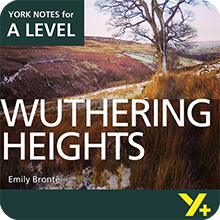Examiner's Notes
You assessed this answer as a High.
Hover over the highlighted text to read the examiner’s comments. These are linked to the Assessment Objectives, which are listed in the side panel.
- You must relate your discussion to relevant contextual factors.
The women of ‘Wuthering Heights’ and ‘Mrs Dalloway’ are involved in a search for identity that is characteristic of women in the modern world. When Catherine answers Nelly’s ‘catechism’ as to whether or not she should marry Edgar, she is convinced that her identity is bound up with that of her adopted brother Heathcliff, that he is a kind of second self who explains everything for her, for ‘What were the use of my creation, if I were entirely contained here?’ The conventional heaven of Christianity does not seem to be her home. The angels fling her out of it. Although she is soon to marry into the property of the Lintons, Catherine is struggling with her deeper self, which tells her that her soul belongs not at Thrushcross Grange but ‘on the top of Wuthering Heights’.
Brontë’s presentation of the passionate struggles of Catherine for identity might be contrasted with her daughter Cathy’s vision of her own happiness on a ‘hot July day’. This places her not on a hilltop but perched in a tree rustling in a western breeze, ‘the whole world awake and wild with joy’. There are thus many ways of coming to terms with the world of nature in this novel, the more edgy Catherine contrasting with her more flexible daughter.
Clarissa Dalloway in Virginia Woolf’s novel has interesting meditations too. Like Catherine she tries to escape the ‘prison’ of the present and get back to a time when she was truly herself at Bourton. Like Catherine she seems to have made a wrong choice, losing her way and her friends: ‘She had gone up into the tower alone and left them blackberrying in the sun.’ Both women find it difficult to contain their imaginations in the real world. Clarissa ‘had a perpetual sense, as she watched the taxi cabs, of being out, out, far out to sea and alone; she always had the feeling that it was very, very dangerous to live even one day.’ Catherine finds her perceptions even harder to control. During her illness she hallucinates, thinking she’s on the moor, or in her old bedroom at the Heights. A woman’s struggle for identity in these books involves repressing thoughts and memories that lead away from the responsibilities of the present time. Catherine, one of the most convincingly wilful heroines ever written, is not prepared to pay that price.
Woolf’s technique as a novelist writing in the Modernist period makes it comparatively easy to see what Clarissa is thinking as she works at the problem of her identity. For much of her novel we are inside her head, reading her thoughts. As Julia Briggs has said, Woolf’s use of free indirect speech is one of the most democratic kinds of literature. Catherine, by contrast, can only be known through Nelly’s narrative about her, and Nelly is a biased source, believing her wayward and ‘arrogant’. Nevertheless, Catherine has a number of long speeches where she tells Nelly what she thinks and feels in some detail. These include the exchange at the Heights where she explains that Heathcliff is as necessary to her as the rocks beneath her feet, and as much a part of her as her own soul. She also recalls her girlhood in great detail during her illness at Thrushcross Grange.
If Catherine and Clarissa are both struggling to come to terms with their identity, the second generation heroines, Catherine and Elizabeth, seem to have found it. Elizabeth moves with confidence and freedom about the big city in an omnibus. Cathy is restricted to rides on her Galloway pony, never too far from the Grange, yet ‘explores’ the landscape with great confidence and poetic feeling. Elizabeth seems in some ways more girlish than Cathy, her dreams of the future (being mistress of a big house) more conventional. That is because Catherine, whose character, like her figure, is ‘elastic as steel’, has to put up with much more than Elizabeth. She does not have the opportunities and security that a twentieth-century lifestyle, and the efforts of the suffragettes, have won for women like Elizabeth. Cathy is kidnapped by the patriarch Heathcliff, assaulted, imprisoned and insulted by him. As Heathcliff’s female dependant she must struggle to maintain her identity, which she does by clinging on to her own space, despite the blows and insults, only occasionally declaring herself ‘dreary’ or ‘stalled’. Where Elizabeth enjoys the relaxed, privileged, even hedonistic lifestyle of the 1920s, Cathy is more like the heroine of a folk-tale, forced for a while to earn her bread as she grapples with the forces of patriarchy. In very traditional fashion she even brings about a happy ending to the novel by marrying the heir of Wuthering Heights, allowing the book to end like a Shakespeare tragicomedy, where hope comes from the young people.
Neither novel explores the role of women in a post-Feminist world, but both show women exploring relative freedoms within the patriarchal set-up. In ‘Mrs Dalloway’ the setting is the largely male world of high politics, the ‘male’ chimes of Big Ben sounding in ‘leaden circles’, the Great War not far away. In ‘Wuthering Height’ the structures of patriarchy are less extensive, but no less threatening. Catherine, peeping into the ‘shimmering’ interior of Thrushcross Grange, is bitten by the guard dog, while her daughter is slapped around by the man who should act as her guardian.
